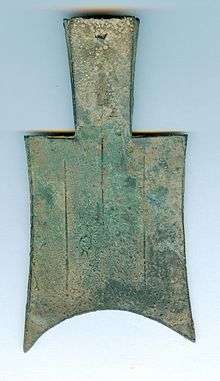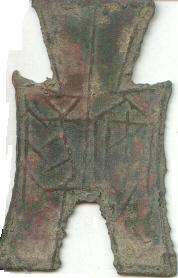Spade money

Spade money was an early form of coin used during the Zhou dynasty of China (1045 to 256 BC). Spade money was shaped like a spade or weeding tool.
Hollow-handled spade money
Hollow-handled spades (Chinese: 布幣; pinyin: bùbì) are a link between weeding tools used for barter and stylised objects used as money. Although flimsy, it retains the hollow socket by which a genuine tool could be attached to its handle. This socket is rectangular in its cross-section and still retains the clay from the casting process. In the socket, the hole that fixes the tool to its handle is also reproduced.
- Prototype spade money: this type of spade money is similar in shape and size to the original agricultural implements. While some are robust enough to have been used in the fields, others are much lighter. These bear an inscription of the name of its issuing city. Some of these objects have been found in Shang and Western Zhou tombs, dating from 1200-800 BC. Inscribed specimens appear to date from c. 700 BC.[1]
- Square shoulder spades: characteristics of this type of spade coin include square shoulders, a straight or slightly curving foot, and three parallel lines on the obverse and reverse. They are found in quantities of up to several hundreds in the area corresponding to the Royal Domain of Zhou (south Hebei and north Henan). Archaeological evidence dates them to the early spring and autumn period, approximately 650 BC and onward.
The inscriptions on these coins usually consist of one character, which can be either a number, a cyclical character, a place name, or the name of a clan. The crude writing is that of the artisans who made the coins, not the more careful script of the scholars who wrote the votive inscriptions on bronze. The style of writing is consistent with that of the middle Zhou period. Over two hundred inscriptions are known. Many have not been fully deciphered. The characters can be found on the left or right of the central line and may be inverted or retrograde. The alloy of these coins is typically 80% copper, 15% lead, and 5% tin. They are found in hoards of hundreds rather than thousands, sometimes tied together in bundles. Although there is no mention in the literature of their purchasing power, it is clear that they were not small change.[2]
- Sloping shoulder spades: these spades usually have a sloping shoulder with the two outside lines on the obverse and reverse at an angle. The central line is often missing. This type is generally smaller than the prototype or square shoulder spades. Their inscriptions are clearer and usually consist of two characters. They are associated with the Kingdom of Zhou and the Henan area. Their smaller size indicates that they are later in date than square shoulder spades.[3]
- Pointed shoulder spades: this type of spade has pointed shoulders and feet and a long hollow handle. There are three parallel lines on the obverse and reverse with occasional inscriptions. They are found in Northeast Henan and Shanxi, the territory of the Duchy of Jin, later to become Zhao. They are held to be somewhat later in date than the square shouldered spades. Their shape seems to be designed for ease of tying together in bundles, rather than deriving from any particular agricultural instrument.[4]
Flat-handled spade money
Flat-handled spade money does not have the hollow handle of the early spades. Nearly all have distinct legs, suggesting that their pattern was influenced by the pointed shoulder hollow-handled spades with further styling for easy handling. They are generally smaller and sometimes have denominations specified in their inscriptions in addition to place names. In combination with the little evidence of establishment dates of some mint towns, flat-handled spade money could have been a later development. Archaeological evidence dates them to the Warring States period (475 to 221 BC). Arched foot spades have an alloy consisting of about 80% copper; for other types the copper content varies between 40% and 70%.[5]
- Arched foot spades: this type has an arched crutch like an inverted U. The shoulders can be rounded or angular. Denominations of half, one, or two jin are normally specified. Arched foot spaces are associated with the State of Liang (also known as Wei), which flourished between 425 and 344 BC, and the State of Han (403-230 BC).[5]
- Special spades of Liang: special spades of Liang are similar in shape to the arched foot spades. Their inscriptions have been the subject of much debate. All now agreed that these coins were issued by the State of Liang, and the inscriptions indicate a relationship between the jin weight of the coins and the lie (another unit of weight or money).[6]
- Pointed foot spades: this type has pointed feet and a square crutch. The shoulders can be pointing upwards or straight. They are a clear descendant of the pointed shoulder hollow-handled spade. The weight and size of the larger specimens is compatible with the one jin unit of the arched foot flat-handled spades. Smaller specimens can often specify the unit as a half jinor one jin (less frequent), but frequently do not specify a unit. This seems to imply that the half jin unit became the norm. They are associated with the State of Zhao and are usually found in Shanxi and Hebei provinces. They frequently have numerals on the reverse side. The two-character mint names mean that the cities that cast these coins can be identified with more certainty than those of earlier series.[7]

- Square foot spades: this type has square feet, a square crutch, and a central line on the obverse. The reverse normally has only three lines apart from on spades produced by some mints in the state of Zhao, who also produced pointed foot spades. These have numerals on the reverse. The mints that produced square foot spades are more numerous than those that produced the pointed foot spades. Their weights are compatible with the half jin denomination. They are associated with the states of Han, Zhao, Liang, Zhou, and Yan. They are found in the provinces of Inner Mongolia, Jilin, Hebei, Shanxi, Shaanxi, Shandong, Jiangsu, Anhui, Henan, and Zhejiang. The type is contemporary, along with the pointed foot spades. Some mints issued both types, and the two are found together in hoards.[8]
- Sharp cornered spades': these form a distinct sub-series of the square foot spades. They differ slightly from the normal type as they have small triangular projections on the handle. The inscriptions of the three larger types include the characters jin (Chinese: 金; pinyin: jīn) and nie (Chinese: 涅; pinyin: niè). While nie was the name of a river in Henan, the character cannot be readily construed as part of a place name, as it is found in conjunction with other place names such as Lu Shi and Yu. According to the Fang Yan (an ancient book on dialects),nie meant the same as hua (Chinese: 化; pinyin: huà), money or coin. Thus the charactersjin nie mean “metal coin”. The weights of the larger coins seem slightly higher than the 14 grams of the jinstandard. Their find spots correspond with the states of Liang and Han.[8]
- Dang Jin spades: these constitute another sub-group whose inscriptions suggest equivalence between the units of two trading areas. Both the small and large coins have a character jin (Chinese: 伒; pinyin: jìn) in their inscription. This is normally taken as being the same as the jin unit found on other flat handled spade coins. However, the 28 gram weight of these coins suggests that their unit was twice the 14 grams of the flat handled spadejin, so perhaps it was a local unit of the area. The smaller coin is often found as two joined together at the feet. This is how they were cast, but it is not clear if they were intended to circulate like this. Their weight is between 7 and 8 grams, roughly a quarter of the larger coins, so the inscription indicating that four were equivalent to a jin is logical. Their obverse inscriptions are a matter of some debate. Taking a consensus, the most logical reading is: [City of] Pei coin equivalent to a jin (Chinese: 斾比當伒; pinyin: pèi bǐ dāng jìn).[9]
- Round foot spades: round handle, round shoulders, and round feet. A rare type. This type is represented by the coins of five cities in present-day Shanxi, between the Fen and Yellow River. There are two sizes, the equivalent of the onejin and half jin denominations. They have various numerals on their reverses. One school of thought ascribes them to the states of Qin and Zhao at the end of the Warring States period; another to the State of Zhongshan during the 4th century BC.[10]
- Three hole spades: holes in the handle and feet. Round handle, round shoulders, and round feet. Another rare type. Two sizes are found. The large size has the inscription liang (Chinese: 兩; pinyin: liǎng) on the reverse; the smaller shi'er zhu (Chinese: 十二銖; pinyin: shí'èr zhū) (12 zhu). As the liang unit of weight was divided into 24 zhu, clearly the two sizes represent denominations of a “one” and of a “half”. They also have series numbers on the handle on the reverse. Like the Round Foot Spades, it is not definitely established which State issued them. Their find spots are in eastern Shanxi and Hebei. The mint names are cities that were occupied by both Zhong Shan and Zhao.[11]
See also
References
- ↑ David, Hartill (September 22, 2005). Cast Chinese Coins. Trafford Publishing. p. 5. ISBN 978-1412054669.
- ↑ David, Hartill (September 22, 2005). Cast Chinese Coins. Trafford Publishing. p. 6. ISBN 978-1412054669.
- ↑ David, Hartill (September 22, 2005). Cast Chinese Coins. Trafford Publishing. p. 14. ISBN 978-1412054669.
- ↑ David, Hartill (September 22, 2005). Cast Chinese Coins. Trafford Publishing. p. 17. ISBN 978-1412054669.
- 1 2 David, Hartill (September 22, 2005). Cast Chinese Coins. Trafford Publishing. p. 19. ISBN 978-1412054669.
- ↑ David, Hartill (September 22, 2005). Cast Chinese Coins. Trafford Publishing. p. 24. ISBN 978-1412054669.
- ↑ David, Hartill (September 22, 2005). Cast Chinese Coins. Trafford Publishing. p. 26. ISBN 978-1412054669.
- 1 2 David, Hartill (September 22, 2005). Cast Chinese Coins. Trafford Publishing. p. 35. ISBN 978-1412054669.
- ↑ David, Hartill (September 22, 2005). Cast Chinese Coins. Trafford Publishing. p. 50. ISBN 978-1412054669.
- ↑ David, Hartill (September 22, 2005). Cast Chinese Coins. Trafford Publishing. p. 52. ISBN 978-1412054669.
- ↑ David, Hartill (September 22, 2005). Cast Chinese Coins. Trafford Publishing. p. 53. ISBN 978-1412054669.